Planning and operation
General info
 The facility has a concession for an annual production of 2 million smolt, but has in recent years yielded less due to limited water resources.
All produced smolt are delivered to nearby ongrowing facilities owned by SalMar, with the exception of some yolk sac fry to another hatchery.
The facility has a concession for an annual production of 2 million smolt, but has in recent years yielded less due to limited water resources.
All produced smolt are delivered to nearby ongrowing facilities owned by SalMar, with the exception of some yolk sac fry to another hatchery.
Production and planning
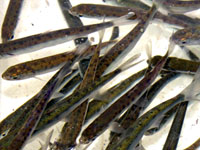 The production plan is formed according to the facility's annual production goals.
These are set by agreement between the facility managers and the regional production manager for Salmar Nord.
Concensus is reached on deliveries of 0-yearolds and 1-yearolds in terms of numbers, average size, and delivery time.
Limiting factors are taken into account when forming the production plan, including availability of eyed eggs, the facility concession, available freshwater, and water heating resources.
The production plan is formed according to the facility's annual production goals.
These are set by agreement between the facility managers and the regional production manager for Salmar Nord.
Concensus is reached on deliveries of 0-yearolds and 1-yearolds in terms of numbers, average size, and delivery time.
Limiting factors are taken into account when forming the production plan, including availability of eyed eggs, the facility concession, available freshwater, and water heating resources.
Production cycle
The facility is operated according to the following production cycle:
| November - December: | Receipt of eyed eggs |
| January - February: | Hatching and start feeding |
| March and onward: | Growth phase |
| August - October: | Delivery of 0-yearolds |
| April-June (following year): | Delivery of 1-yearolds |
Movement of fish in the facility
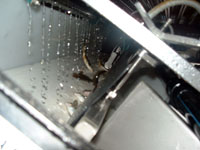 At Rognbanken, eyed eggs are incubated and hatched in hatching trays.
The fry are then moved to the octagonal start-feeding tanks at 240 day degrees, or when the oxygen saturation in the outlets reaches 90%.
Start feeding continues until the density in these tanks reaches 40-50 kg/m3, after which the fish are graded for the first time.
At Rognbanken, eyed eggs are incubated and hatched in hatching trays.
The fry are then moved to the octagonal start-feeding tanks at 240 day degrees, or when the oxygen saturation in the outlets reaches 90%.
Start feeding continues until the density in these tanks reaches 40-50 kg/m3, after which the fish are graded for the first time.
The largest grade is retained in the big indoor tanks with heated water to become 0-yearolds, while the remaining grades are moved outdoors to become 1-yearolds. From indoors in Rognbanken, the 0-yearolds are moved to the 14 meter outside tanks.
At Gjøvik settefisk, eyed eggs are incubated and hatched in floating hatching boxes within the start-feeding tanks. The fry are then start fed until the density reaches 40-50 kg/m3, after which first grading occurs. Some fish are then moved to Rognbanken to become 0-yearlods, some are retained to become the second batch of 0-yearolds, and the remaining are moved out to become 1-yearolds.
Operations in Gjøvik settefisk
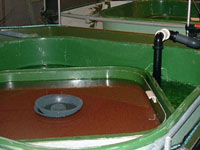 Here, the tanks serve as combined incubation, hatching, start-feeding, and early growth tanks.
Before eyed eggs are received, the entire facility is dried, cleaned and disinfected thoroughly.
Here, the tanks serve as combined incubation, hatching, start-feeding, and early growth tanks.
Before eyed eggs are received, the entire facility is dried, cleaned and disinfected thoroughly.
When the eyed eggs arrive, they are given a bath in Buffodine solution for 10 minutes before they are placed in the hatching boxes. The stocking density is 50.000 eyed eggs per hatching box, and egg mortality is generally low (60-80 eggs per box). Dead eggs are removed by visual inspection and mouth siphoning.
At first grading, the fish are split into three size grades. The smallest of these is then graded again and the smallest subsequent grade, consisting only of runts, is destroyed.
Operations in Rognbanken
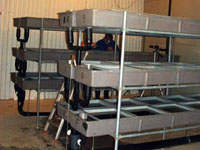 Incubation and hatching occur in a separate room where the system of trays and boxes with hatching substrates (astroturf) are used.
Before receiving the eyed eggs, the entire room and equipment is dried, cleaned and disinfected.
Incubation and hatching occur in a separate room where the system of trays and boxes with hatching substrates (astroturf) are used.
Before receiving the eyed eggs, the entire room and equipment is dried, cleaned and disinfected.
When the eyed eggs are received, they are incubated in the hatching boxes at a density of about 8500 eggs per box, and dead eggs are removed by mouth siphoning. After hatching, the yolk-sac fry are kept in the hatching boxes for 3-4 weeks until the yolk sac is depleted. They are then carried out to the start feeding tanks.
The photoperiod for fry is 24h light, but 0-yearolds start the manipulation regime when they reach 17-18 grams, changing the photoperiod to 12L:12D for 6 weeks.
Operations in the 14 m tanks
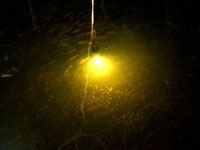 The 14 meter tanks are used in the last growth phase before set-out, primarily for 0-yearolds.
Before being stocked, the tanks are dried, cleaned and disinfected.
The parr are then moved here when they are 30-35 grams and have been graded and vaccinated.
The 14 meter tanks are used in the last growth phase before set-out, primarily for 0-yearolds.
Before being stocked, the tanks are dried, cleaned and disinfected.
The parr are then moved here when they are 30-35 grams and have been graded and vaccinated.
Photoperiod control is achieved with a tarpaulin tent, and both submerged and overhead flood lights. Once they are transferred to the 14 meter tanks, the photoperiod changes to 24h light and lasts until set-out (usually another 6 weeks).
The main tasks associated with this area are: visual inspection of the fish, removing morts, verifying oxygen levels and adjusting the feeding via the central feeding system.
Operations in the outdoor area
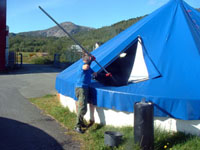 The fish stocked in the outdoor area is exclusively for production of 1-yearolds.
Before stocking the tanks, they are dried, cleaned and disinfected.
The fish stocked in the outdoor area is exclusively for production of 1-yearolds.
Before stocking the tanks, they are dried, cleaned and disinfected.
Photoperiod control is achieved with tarpaulin tents fitted with overhead floodlights. 1-yearolds receive a constant 12L:12D photoperiod regime.
The main tasks associated with this area are: visual inspection of the fish, removing morts, verifying oxygen levels and adjusting the feeding via the central feeding system.
Shipping of smolt
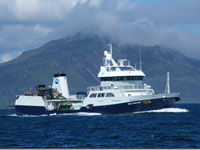 All shipping of smolt from the facility is now done by wellboat.
Due to the shallow water of bay, the well boat anchors up 80-100 m from land, where the depth is above 5 m.
A flexible hose is then carried by boat/dingy out to the wellboat for pumping using the wellboat's powerful vacuum pump systems.
All shipping of smolt from the facility is now done by wellboat.
Due to the shallow water of bay, the well boat anchors up 80-100 m from land, where the depth is above 5 m.
A flexible hose is then carried by boat/dingy out to the wellboat for pumping using the wellboat's powerful vacuum pump systems.
Production monitoring
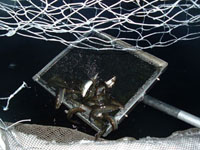 In order to monitor production, the first counting is done upon delivery of eyed eggs (in the presence of the egg supplier).
After this all mortalities are logged to keep track of the stock count.
In order to monitor production, the first counting is done upon delivery of eyed eggs (in the presence of the egg supplier).
After this all mortalities are logged to keep track of the stock count.
To monitor average weights, and thereby estimated biomass, weight samples are taken at 600, 800, 1000 and 1200 day degrees. This is done by the same man at the same spot in the tank, and two sample groups are extracted by hand net. If the deviation of the two averages excees 10%, a third sample is taken.
This usually yields reliable estimates that are later verified during grading and vaccination, where automated fish counters are used and additional weight samples are taken.
Disease control
The facility has not experienced any disease outbreaks during the past 13 years. For disease prevention and monitoring, they submit to a mandatory veterinary health check of the stock, which is performed by the local Fish Health Service. Other preventative measures include strict separation of successive generations, thorough disinfection of tanks whenever fish are moved, and disinfection protocols for employees as they move between areas. Not using seawater also significantly lowers the risk of infection.